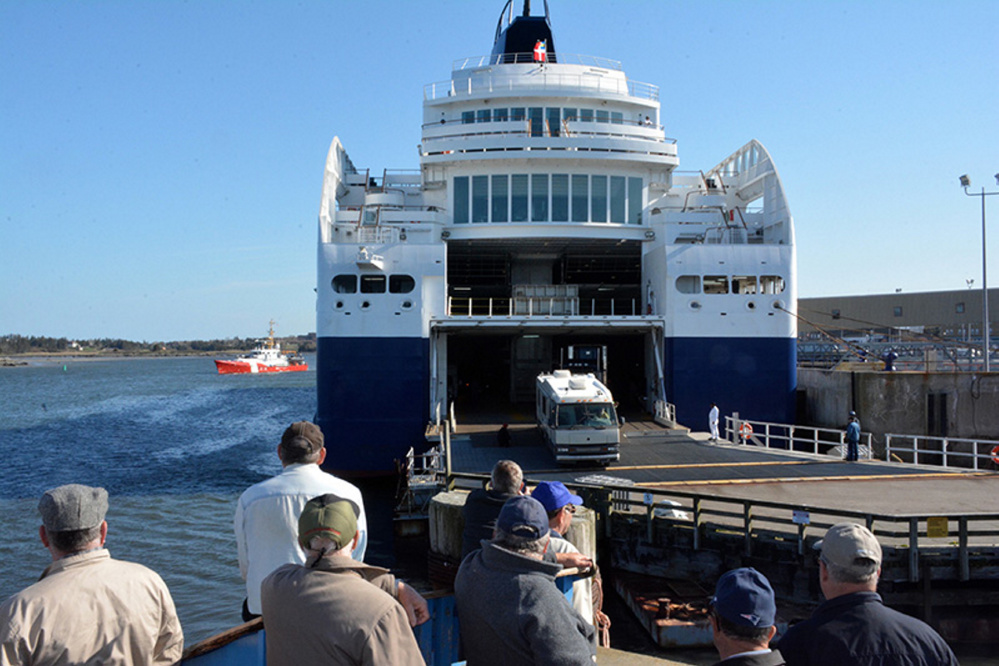Nova Scotia’s government is pulling the plug on the costly Nova Star ferry service and intends to award the Portland-to-Yarmouth, Nova Scotia, route to Bay Ferries, the company that had operated a high-speed ferry service on the same route until 2010.
Geoff MacLellan, Nova Scotia’s minister of transportation, announced Thursday that the Canadian company Bay Ferries Ltd. is the preferred candidate for the route. Mark MacDonald, chief executive of Bay Ferries, is expected to create a plan for the service and bring it to the government within 45 days.
“It came down fundamentally to their experience and expertise and their understanding of the market,” MacLellan said of Bay Ferries.
He said there is no final decision on what kind of vessel Bay Ferries will use, but he is confident that MacDonald is up to the task, even though it’s a “risky” decision to take on the new route.
“Mark MacDonald and Bay Ferries really get this,” MacLellan said of the Maine-to-Nova Scotia service, which is considered crucial to the province’s tourism industry.
He said the two sides are discussing a 10-year contract because it would provide the company and the province with long-term stability.
MacLellan also expressed frustration with Nova Star Cruises, the Maine-based operator of the ferry service for the past two seasons, because of its requests for additional funding and financial reporting delays.
“We had serious challenges with the Nova Star operations,” he said. “It made it difficult for us to continue with that relationship.”
The Nova Star’s performance over the past two seasons has been disappointing, with the ferry carrying fewer passengers than anticipated and costing Nova Scotia taxpayers a lot more than expected.
A provincial government plan in 2012 projected the ferry service would carry 110,000 passengers annually, and Nova Star President Mark Amundsen predicted it would carry 100,000 passengers. Instead, the Nova Star carried 59,000 passengers in its inaugural season and 52,000 in its second season, a 12 percent decline.
The province spent $28.5 million (Canadian) for the service in its inaugural season. Included was a $21 million loan that was intended to last seven years. This year, the government limited its subsidy to $13 million, equal to nearly $10 million (U.S.) at current exchange rates.
Four companies – including Nova Star Cruises – had submitted proposals to run the service next year.
Bay Ferries operated the Cat, a high-speed ferry between Yarmouth and Portland, until canceling the service on Dec. 18, 2009, after the provincial government refused to continue its subsidy because it was losing too much money. Beginning with the 2006 and continuing into the 2007 operating seasons, the Nova Scotia government provided an annual $1.5 million subsidy to Bay Ferries to offset declining passenger revenue and increased fuel costs. The ferry operator had been seeking about $6 million for its 2010 season, which the government rejected, leading to the cancellation of the service.
Bay Ferries has a main office in Charlottetown, Prince Edward Island, and a smaller office in Halifax, Nova Scotia. It is a subsidiary of Northumberland Ferries Ltd., also based in Charlottetown.
Bay Ferries operates the Fundy Rose, which has daily crossings between Digby, Nova Scotia, and Saint John, New Brunswick.
MacDonald said in a written statement that he’s pleased the province has selected his company. “We understand the importance of this gateway to the province and want to work with the province in rebuilding this key transportation corridor,” he said.
While Yarmouth will serve as the Nova Scotia port for the ferry route, it’s unclear whether Portland will continue to serve as the port in Maine. The Nova Scotia minister would not say when asked by reporters at a news conference in Halifax. Although Portland is seen as the best destination from the perspective of tourism, that’s a decision for Bay Ferries to make, he said.
Bar Harbor currently doesn’t have port facilities for a ferry.
Portland City Manager Jon Jennings said in a written statement that the city is looking forward to negotiating a contract with Bay Ferries for use of the city-owned ferry terminal.
“We’d like to thank the provincial government for their commitment to the ferry, and we are pleased that they have chosen an operator that has experience in providing this service,” Jennings said.
Canamerica Cruises, a group led by Bruce McNeil of Nova Scotia, had also submitted a bid to provide ferry service. MacLellan would not provide the name of the fourth bidder.
Amundsen, the Nova Star Cruises president, said in a written statement that the company is disappointed it wasn’t selected to continue operating the ferry service.
“We would like to thank the people of Nova Scotia for their support over the past two years, and we will work with the Province of Nova Scotia toward a smooth transition to the 2016 operating season,” he said.
Reversing the trend of falling passenger volumes will be a difficult task for any new operator. Critics of the troubled Nova Star service say it would do a lot better if it had a less expensive vessel or a more savvy operator, but experts in the ferry and tourism industries say that the service has suffered from large-scale shifts in recreation and business behaviors, such as:
• Americans are taking shorter vacations than in the past. The well-planned, two-week family excursion has been replaced by the last-minute weekend getaway. Many Americans don’t have the time to travel all the way to Nova Scotia and back, no matter what mode of transportation they use.
• The explosive growth of the $117 billion global cruise ship industry has given consumers more options for travel at sea. Between 2009 and 2013, the number of people who took a cruise trip rose from 17.8 million to 23 million annually, an increase of nearly 30 percent, according to industry data. The cruise industry has done this by containing costs and giving consumers value for their money.
Send questions/comments to the editors.




Comments are no longer available on this story